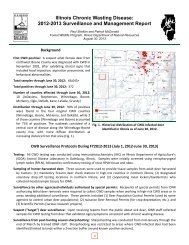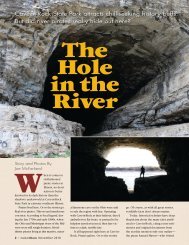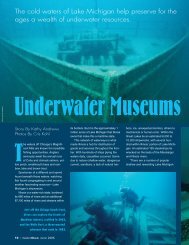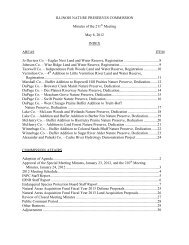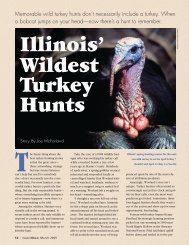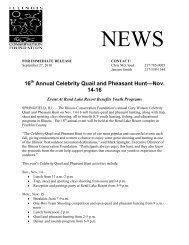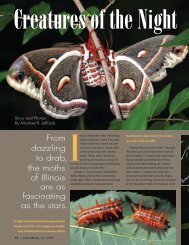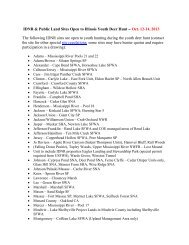OutdoorIllinois April 2010 Hidden Springs State Forest - Illinois DNR
OutdoorIllinois April 2010 Hidden Springs State Forest - Illinois DNR
OutdoorIllinois April 2010 Hidden Springs State Forest - Illinois DNR
You also want an ePaper? Increase the reach of your titles
YUMPU automatically turns print PDFs into web optimized ePapers that Google loves.
This secluded<br />
forest retreat<br />
in central<br />
<strong>Illinois</strong> enjoys a<br />
perfectly shady<br />
reputation.<br />
<strong>Hidden</strong><br />
<strong>Springs</strong><br />
<strong>State</strong><br />
<strong>Forest</strong><br />
Story By Kathy Andrews<br />
Photos By Adele Hodde<br />
Plans for the central <strong>Illinois</strong> landscape<br />
took a sharp U-turn in<br />
the late 1950s and early 1960s.<br />
At the time, the state was<br />
acquiring land in Shelby County<br />
for the creation of a reservoir. When<br />
the U.S. Army Corps of Engineers<br />
rue anemone, Anemonella thalictroides<br />
2 / <strong>Outdoor<strong>Illinois</strong></strong> <strong>April</strong> <strong>2010</strong><br />
announced plans to dam the Kaskaskia<br />
River and create Lake Shelbyville, the<br />
state reconsidered the need for two<br />
reservoirs in Shelby County. As a result,<br />
Shelby County <strong>State</strong> <strong>Forest</strong>, subsequently<br />
renamed <strong>Hidden</strong> <strong>Springs</strong> <strong>State</strong> <strong>Forest</strong><br />
after the seven known springs on the<br />
site, was born.<br />
Site Superintendent Rick Goble<br />
says that the designation of the<br />
1,229-acre site as a state forest does<br />
cause some confusion.<br />
“Many people see the sign on the<br />
road and drive right past us, thinking<br />
that the area is just a bunch of trees,”<br />
Goble remarked. “In reality, <strong>Hidden</strong><br />
<strong>Springs</strong> is a multi-use recreation area,<br />
combining sound timber and resource<br />
management with compatible recreational<br />
opportunities such as hiking,<br />
hunting, fishing, camping and a popular<br />
day-use area.”<br />
With 7 miles of trails passing<br />
through gently rolling terrain and 17<br />
miles of fire trails providing access to<br />
remote sections of the forest, hikers<br />
can experience coniferous and hardwood<br />
timber, 200 acres of restored<br />
prairie and picturesque views of Richland<br />
Creek. Only foot traffic is allowed,<br />
and all trails have benches where visitors<br />
can rest, reflect and watch wildlife.<br />
Two trails pass by two of the forest’s<br />
namesake springs.
Although designated as a<br />
state forest, <strong>Hidden</strong> <strong>Springs</strong><br />
offers visitors a diversity of<br />
recreational opportunities.<br />
At the northeastern corner of the forest,<br />
the 1-mile Big Tree Trail offers visitors<br />
a chance to gaze upon Quicksand<br />
Spring. Sadly, the origin of the trail name<br />
is lost to history as no quicksand exists.<br />
“Although it no longer stands, Big<br />
Tree Trail was named for a 78-inch<br />
diameter sycamore tree, once one of<br />
the largest in the state,” Goble said.<br />
“All that remains now is a chimney of<br />
decaying wood that provides a buffet<br />
for insects and insect-eaters.”<br />
A second spring, Rocky Spring,<br />
is accessible from the Rocky Spring<br />
Nature Trail located at the opposite<br />
corner of the park. The longest of the<br />
forest’s trails, Rocky Spring provides a<br />
3-mile loop that traverses through all<br />
habitat types found in the state forest,<br />
past forest improvement and walnut<br />
production areas and it parallels Richland<br />
Creek for nearly a mile. Rocky<br />
Spring Nature Trail has historical<br />
significance as it follows a segment of<br />
the road area settlers used to travel to<br />
and from Vandalia.<br />
Indian Head Spring, Stone Head<br />
Spring and Fern Spring are a few of the<br />
other known springs scattered throughout<br />
the timber. Other springs may<br />
exist, but likely have been covered with<br />
years of sediment.<br />
Trail guides available at the site<br />
headquarters and the trail head provide<br />
information about the 35 interpretive<br />
stations posted along the ¾-mile Possum<br />
Hollow Nature Trail. The self-guided trail<br />
is popular with school groups and youth<br />
organizations and provides information<br />
on trees and habitat features.<br />
Want a sneak peek at Possum Hollow<br />
Nature Trail? Check out the selfguided<br />
picture tour at dnr.state.il.us/<br />
lands/landmgt/parks/r3/hsforest.htm.<br />
Birders enjoy taking to the trails in<br />
search of some of the more than 110<br />
species of feathered fauna present seasonally.<br />
In addition to enjoying a woodland<br />
floor carpeted with wildflowers,<br />
spring visitors are especially delighted<br />
with the presence of nearly 20 species<br />
of warblers, including black-and-white,<br />
orange-crowned, bay-breasted, Ken-<br />
Great opportunities for viewing<br />
wildlife exist on trails paralleling<br />
Richland Creek, a tributary of the<br />
Kaskaskia River.<br />
<strong>April</strong> <strong>2010</strong> <strong>Outdoor<strong>Illinois</strong></strong> / 3
luebells, Mertensia virginica<br />
wild turkey, Meleagris gallopavo<br />
trillium, Trillium sp.<br />
Henry’s elfin butterfly,<br />
Callophrys henrici<br />
bloodroot, Sanguinaria canadensis<br />
An oak tree provides an arbor of<br />
fall color at one of <strong>Hidden</strong> Spring’s<br />
popular day-use areas.<br />
tucky and yellow-throated. A checklist<br />
of known species is available at the<br />
office and on the Web site.<br />
Richland Creek flows into the<br />
Kaskaskia River and provides a natural<br />
travel corridor for wildlife. Deer and<br />
wild turkeys are frequently spotted<br />
within the forest, and a recent increase<br />
in the number of river otters sighted<br />
has wildlife watchers on alert.<br />
As one of <strong>Illinois</strong>’ four designated<br />
state forests, nearly 70 percent of <strong>Hidden</strong><br />
<strong>Springs</strong> is timbered. Most of the<br />
timber is classified as a mature, secondgrowth<br />
oak-hickory forest, although<br />
there is a 200-acre conifer plantation<br />
composed of white, red and scotch<br />
pines. The forest does offer a firewood<br />
collection program, allowing individuals<br />
to obtain a permit to cut up to two<br />
pickup loads of wood in assigned areas.<br />
Firewood must be for personal use only<br />
and a $10/load fee is assessed.<br />
Significant timber resources make<br />
<strong>Hidden</strong> <strong>Springs</strong> a prime destination for<br />
deer (archery and firearm), spring wild<br />
turkey and squirrel hunters. Restored<br />
prairie patches and 25-acres of sunflowers<br />
planted annually enhance rabbit,<br />
quail, ring-necked pheasant and dove<br />
hunting. All but 200 acres of the site<br />
are open to hunting.<br />
Firearm deer hunters are required to<br />
possess a site-specific permit. All other<br />
hunters and trappers must pick up a free<br />
site permit at the office and display a<br />
windshield card while hunting at <strong>Hidden</strong><br />
<strong>Springs</strong>. Windshield cards must be<br />
turned in by February 15th as the harvest<br />
data provides biologists with information<br />
crucial to wildlife management decisions,<br />
and failure to comply means loss of hunting<br />
privileges at the site for one year. In<br />
most cases statewide regulations apply;<br />
however, consulting the Web site or contacting<br />
the forest headquarters for additional<br />
information is advised.<br />
Archers may want to drop by the<br />
forest to hone their skills on the free<br />
3-D archery range. The range has 23<br />
targets of a variety of species and is<br />
open year-round.<br />
Not to be left out, anglers may wet a<br />
line at any of five ponds located within<br />
the forest. Ranging in size from ¾-1¼<br />
acres, Hickory Ridge and Prairie ponds<br />
are accessible by vehicle, while a short<br />
jaunt is required for those desiring to<br />
fish White Oaks, Sassafras and Park<br />
(Photo by Joe McFarland.)<br />
4 / <strong>Outdoor<strong>Illinois</strong></strong> <strong>April</strong> <strong>2010</strong>
Earth Day in the Parks<br />
ponds. Each pond is annually stocked<br />
with channel catfish, bluegill, redear<br />
and largemouth bass. Richland Creek<br />
provides limited fishing opportunities.<br />
The Possum Creek campground features<br />
28 Class C (four yard hydrants, a<br />
privie and sanitary disposal station)<br />
sites with pedestal stoves, fire blocks<br />
and a fire ring. Campers may set up<br />
camp on the site of their choice, or<br />
may make a reservation by contacting<br />
the forest headquarters.<br />
Shady Grove Campground, a group<br />
camp large enough to accommodate<br />
scout and church groups also is available.<br />
Also a family-friendly destination,<br />
Rolling Meadows Day Use Area contains<br />
a volleyball court, softball diamond,<br />
horseshoe pits and two additional sets<br />
of playground equipment. Drinking<br />
Andrew Goble (left), Stewardson,<br />
and Blake Lilly, Mode, enjoy a<br />
fall upland game hunt at <strong>Hidden</strong><br />
<strong>Springs</strong>.<br />
water, privies, tables, stoves and a fire<br />
ring round out the available amenities.<br />
The large picnic shelter averages four to<br />
six weddings, and numerous family<br />
reunions, each year and may be<br />
reserved through the site headquarters.<br />
Additional day-use sites include Red<br />
Bud Lane, on the south end of the<br />
Rolling Meadows Day Use Area, where<br />
three small, secluded sites provide intimate<br />
picnic settings, and a small picnic<br />
area near the Big Tree Nature Trail.<br />
Tables and stoves are available at both.<br />
As a state forest, <strong>Hidden</strong> <strong>Springs</strong> is<br />
an ideal location for research that will<br />
benefit sound timber and resource management.<br />
The <strong>Illinois</strong> Natural History<br />
Survey has conducted two research<br />
projects on the invasive garlic mustard,<br />
one on demography and one on the<br />
biochemical interactions that inhibit<br />
the growth of neighboring plants by<br />
another plant.<br />
<strong>Hidden</strong> <strong>Springs</strong> was part of a network<br />
of 10 sites sampled twice a year<br />
during the garlic mustard demography<br />
study. Information gathered included<br />
size of the population, plant growth<br />
stage and what plants were growing<br />
with garlic mustard. This information<br />
was collected to investigate the population<br />
dynamics of garlic mustard before<br />
the introduction of biological control<br />
agents. (No agents have been approved<br />
for release at this time.)<br />
The second multi-site field study<br />
tested how the efficiency and efficacy<br />
of restoration activities (hand pulling of<br />
garlic mustard and restoring the healthy<br />
soil microbial communities) depended<br />
on the age or biochemical concentration<br />
of garlic mustard.<br />
According to INHS post-doctoral<br />
researcher Richard Lankau, results of<br />
the study provide land managers with<br />
two, key management recommendations:<br />
restoration activities will probably<br />
be more successful in areas with a<br />
longer history of garlic mustard invasion<br />
and, also, knowing something about the<br />
history or toxicity of the garlic mustard<br />
population can help determine how<br />
much effort is necessary for the restoration<br />
to be successful.<br />
Next time you are traveling down<br />
the road, or looking for a new site for<br />
the family to explore, consider <strong>Hidden</strong><br />
<strong>Springs</strong> <strong>State</strong> <strong>Forest</strong>—a site that holds<br />
hidden springs and many other wonders<br />
for you to discover.<br />
At a glance<br />
<strong>Hidden</strong> <strong>Springs</strong> <strong>State</strong> <strong>Forest</strong>,<br />
R.R. 1, Box 200, Strasburg, Ill. 62465<br />
Telephone: (217) 644-3091<br />
Web site: dnr.state.il.us/lands/land<br />
mgt/parks/r3/hsforest.htm<br />
Directions: Exit Interstate 57 at Mattoon<br />
and proceed west on Route 16<br />
through town. Continue west on Route<br />
16 through the towns of Gays and<br />
Windsor. Two miles west of Windsor,<br />
turn left (south) on <strong>Illinois</strong> Route 32<br />
and proceed 4 miles through Strasburg,<br />
then 2 miles to the entrance.<br />
In the area: Located only 10 miles<br />
south of Lake Shelbyville, a visit to<br />
<strong>Hidden</strong> <strong>Springs</strong> <strong>State</strong> <strong>Forest</strong> easily can<br />
be part of a weekend getaway or a<br />
family vacation.<br />
History buffs will enjoy the Thompson<br />
Mill Covered Bridge, one of only<br />
five covered bridges remaining in <strong>Illinois</strong><br />
and located 4 miles east of Cowden.<br />
Built in 1868, the 157-foot bridge<br />
is only 10-feet, 7-inches wide and was<br />
constructed to provide Effingham to<br />
Springfield travelers transportation<br />
across the Kaskaskia River. Traffic is no<br />
longer allowed on the bridge, but the<br />
adjacent replacement bridge provides<br />
easy foot access.<br />
For additional information on area<br />
parks, historical sites, events, accommodations<br />
and more, visit lakeshelby<br />
ville.com.<br />
<strong>April</strong> <strong>2010</strong> <strong>Outdoor<strong>Illinois</strong></strong> / 5




